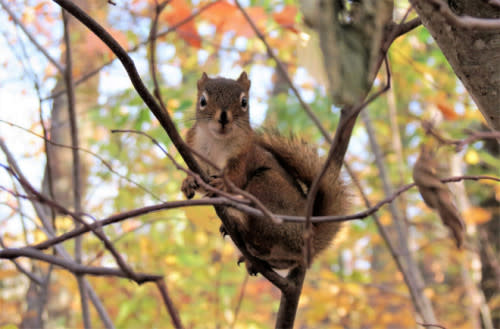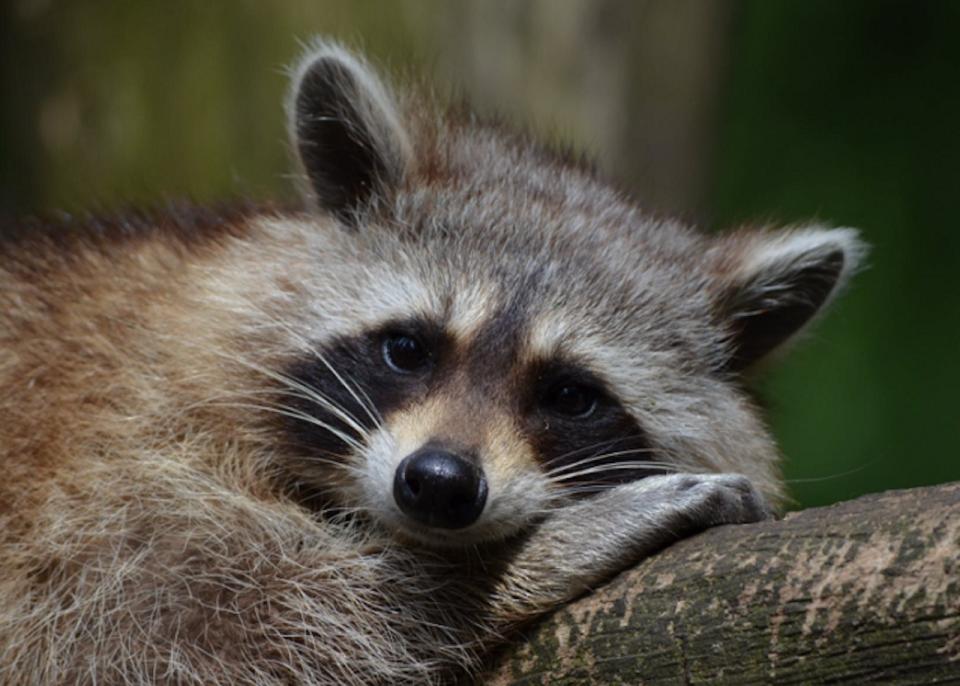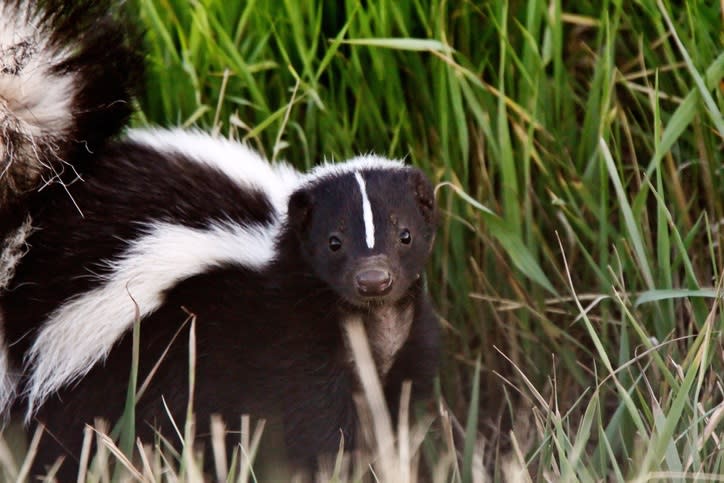From foe to friend: How to change perceptions of 'nuisance' wildlife

Our neighbourhoods are filled with animals of varying species and sizes, so it's no surprise that some are perceived as troublesome for a myriad of reasons.
But they don't need to be thought of as pests or bothersome. There are ways to peacefully coexist with them as all animals play important roles in the ecosystem.
SEE ALSO: How and where to go on a safe quest to see wildlife in Canada
But why are certain species viewed as problematic? How can we change people's perceptions of animals such as squirrels, chipmunks, pigeons, coyotes and bears, among others?
The Canadian Wildlife Federation's (CWF) James Page, species at risk and biodiversity specialist, and Terri-Lee Reid, freshwater researcher, addressed those issues in a written response submitted to The Weather Network earlier this fall.
Educating people on the challenges wildlife face as a result of residential, industrial and agricultural development eliminating their natural habitats is a start, said Page. Even just increasing knowledge of the diversity and the role each species plays in rural and urban ecosystems is helpful.

(Sharron Grotegut/Submitted)
"Once people know the value of a species and the impact of habitat loss, they may be more sympathetic to the steps needed to help protect it," said Page.
As part of gaining awareness, Page recommends people scour local wildlife observations uploaded to iNaturalist or use its image recognition software to snap a photo and educate themselves on species they may not know about.
Important to find ways to coexist
When possible, it’s important to find ways to coexist with wildlife, Reid added. Animals are often attracted to our properties for multiple reasons, whether it's for food, shelter or other motives. In cases where these sources can be eliminated, oftentimes the issue resolves itself.
"It’s important to remember we share the landscape with a range of wildlife species. These species have important roles to play. They aid in seed dispersal, germination, pest control and waste breakdown, for example," said Reid.
As for what qualifies as a nuisance animal, CWF doesn't have a definition. "Some people love seeing and even photographing squirrels, whereas other people try to deter them from their properties," said Reid.
Page weighed in, saying "one person’s nuisance is another person’s hobby" because some like to feed squirrels that visit their yard while others choose not to for fear of attracting other animals.

(Pexels)
"Others would think leaving food out for squirrels attracts other guests like raccoons, voles or skunks. Wildlife become a nuisance when they cause damage, attack pets or are no longer fearful of human interaction. That presents risk to both humans and animals," said Page.
Depending on the animal, timing and other factors, dealing with wildlife perceived as an annoyance can be "challenging, even frustrating," Reid said. For example, a skunk who has burrowed under a deck or a shed could be considered a nuisance.
"It’s important to remember, though, that we share these landscapes with wildlife. In most cases, there are ways to coexist with these animals," said Reid.
Certain areas will see seasonal influxes of wildlife, typically when food may be more scarce, rendering animals a "bit more desperate" in winter and spring, for example, Page said. The latter is also the time when wildlife will scatter and seek out or expand their home ranges, but there are times when you will see them in the summer.
WATCH: Why fall is the most important season to be bear aware
Such was the case with multiple coyote attacks in parts of Eastern and Western Canada this year. Or, you may see bears wander into populated areas looking for easy food sources, he added.
"The nuisance factor increases as the risks to both humans and animals rise. While some animals are adapting to urbanization, diminishing natural habitats and habitat fragmentation can increase human-animal interaction, which can be dangerous," said Page.
In some cities, increasing pigeon populations or Canada geese are considered a nuisance. While beauty is in the eye of the beholder, not everyone "loves to be chased by a goose while walking [along] a city waterfront," the species at risk and biodiversity specialist said.
One season that "comes to mind" is the spring, when many animals are in birthing mode, Reid said. To find an ideal spot to give birth, wildlife such as raccoons and squirrels will attempt to get into people's attics, groundhogs and skunks will try to slide under decks and sheds, birds may build nests by the doors or foxes may build dens too close for comfort, she added.
"While these may present inconveniences and even concerns, it is typically for a short period of time and based on proper timing," said Reid.

(Getty Images/Fabiomichelecapelli Creative #: 189310324)
Still, there are ways to deter these wildlife, and animal-proofing can be done to prevent it from happening again, she noted.
"Even with the case of deer eating the plants you spend a lot of time and money on, there are a variety of gentle deterrents to try, as well as plants to grow that are considered deer-resistant," said Reid. "Diminishing natural habitats and habitat fragmentation can increase human-animal interaction, and we need to find ways to coexist when possible."
Animals viewed as 'problematic' differs by situation
Page noted that the situation, location and people’s viewpoints determine which animals are most seen as bothersome, whether it's a "true or simply perceived inconvenience."
For example, historically, in rural areas with plenty of livestock or poultry, natural predators like wolves, coyotes, foxes and weasels are targeted as nuisance animals because they could attack domestic animals. Skunks, raccoons and squirrels are often spotted in urban environments, particularly concerning for urban gardeners. Coyotes are also becoming more prevalent in urban areas.
"Again, some people like the fact that wildlife finds a way to coexist with human activity," said Page.
Reid said it is important for us to remember that every species has a biological role. For instance, many people tend to have a "real dislike" for skunks. One reason is that they can make small holes in our lawns. However, they’re actually helpful creatures because they rid our lawn of grubs, she added.

(Getty Images)
"In many instances it’s a matter of finding the balance, tolerating where possible, gently repelling and/or preventing access where needed and appreciating that they also have a right to exist," said Reid.
Feeding can result in 'subsidized predators'
While you may be tempted to provide food for some of the cuter animals, doing so can make them become reliant on that supply -- "sometimes to a fault," Page said, rendering them less likely to fend for themselves when needed. This can also lead to unwanted attention and human-wildlife conflict from animals not intended to be the recipient of the food.
"Areas prone to bear encounters should certainly avoid leaving out any food source and the same goes for other less dangerous animals if you don’t want to be constantly cleaning up after them," said Page.
These types of wildlife can become what are called "subsidized predators," Page added. These animals, due to human food sources, are able to reproduce in large numbers and prey on other parts of the food chain, like turtle nests, where predation is one of the contributing threats to the declining populations of the reptiles.
However, like many rules in life, there is an exception in this case -- bird feeders. Page noted studies have shown that birds do not lose their ability to find natural food sources.

(Darren Harris/Submitted)
"In this case, it’s critical to provide quality food [that] can supplement their diet as opposed to filler that lacks appropriate nutrients," said Page. "Human food is not always the best diet for wildlife. Breads, for example, are horrible for birds. In fact, CWF has developed commercially available bird seed through working with an animal nutritionist for this very reason."
Wildlife is best served when responsible for its own food sources, he added. Government intervention in the form of local bylaws may be necessary if excessive feeding of wildlife has resulted in increased rat populations, for example, or shorelines have seen an increase in geese populations.
Relocation and extermination aren't viable options
When one considers options to dealing with a problem animal, they may think trapping and relocating is an easy solution, but it isn't, Reid said.
"When you trap and release, it can be stressful for that animal. It now has to find suitable food and shelter all while competing with the other animals there. Plus, there’s the risk of spreading disease," she said.
Also, removing that particular individual might only allow another animal to take its place in that area. Wildlife is everywhere, so if that spot was regarded as "great habitat" by one animal, another will gladly use it, Reid stated.

(Getty Images)
Plus, there are provincial rules and regulations when it comes to trapping and releasing animals. Page noted there are laws in many areas that prohibit relocating and exterminating wildlife without a proper permit. He highly recommends people check local bylaws and provincial regulations before thinking about either of these options.
"Bats, for example, have received the brunt of misguided fears, yet several species are endangered in Canada, therefore protected by law, not to mention play a critical role in insect control," said Page.
WATCH: Coyotes in your neighbourhood? Here's how to coexist and stay safe
For the cases an animal comes into a dangerous situation, for both itself and humans -- such as when a bear or moose wanders into an urban area -- relocation is done by professionals in a safe manner, Page said, noting the animal is placed into a suitable habitat away from people.
"There are always consequences to eliminating wildlife from its natural habitat or ecosystems where wildlife serves a purpose," said Page. "Many wild species that are beneficial to humans and the ecosystem such as bats serve as insect control. Birds that pollinate, disperse seed or prey on small mammals like mice, are utilizing urban (including human-made structures) areas as their natural habitat."

Because food and shelter are just as important to animals as they are to us, you can discourage them by preventing their access to food and shelter sources, Reid said.
For instance, ensure your garbage is in a well-sealed container. If you feed birds, keep the seed in a secure container and buy seeds that you know the local species will eat.
"Grow more native perennials and let the seed heads remain on the plant for the winter as a natural food source for many birds. Seal off under your deck with a welded wire mesh to prevent some animals from making dens there," said Reid.
For more helpful ideas, visit CWF's website.
WATCH: Should you be concerned about that fox family in your neighbourhood?
Thumbnail courtesy of Sharron Grotegut/Submitted.
Follow Nathan Howes on Twitter.

 Yahoo Movies
Yahoo Movies 
